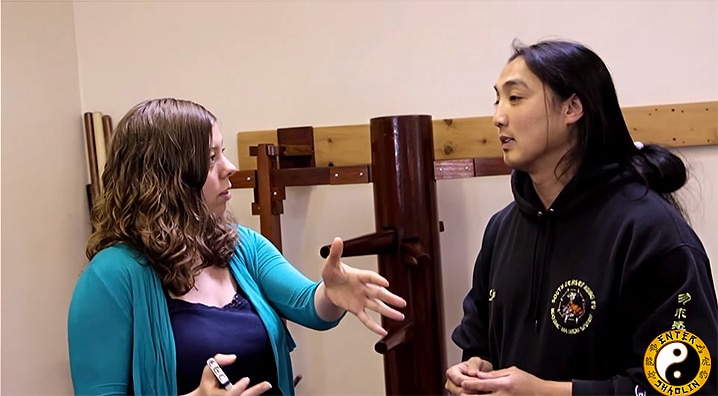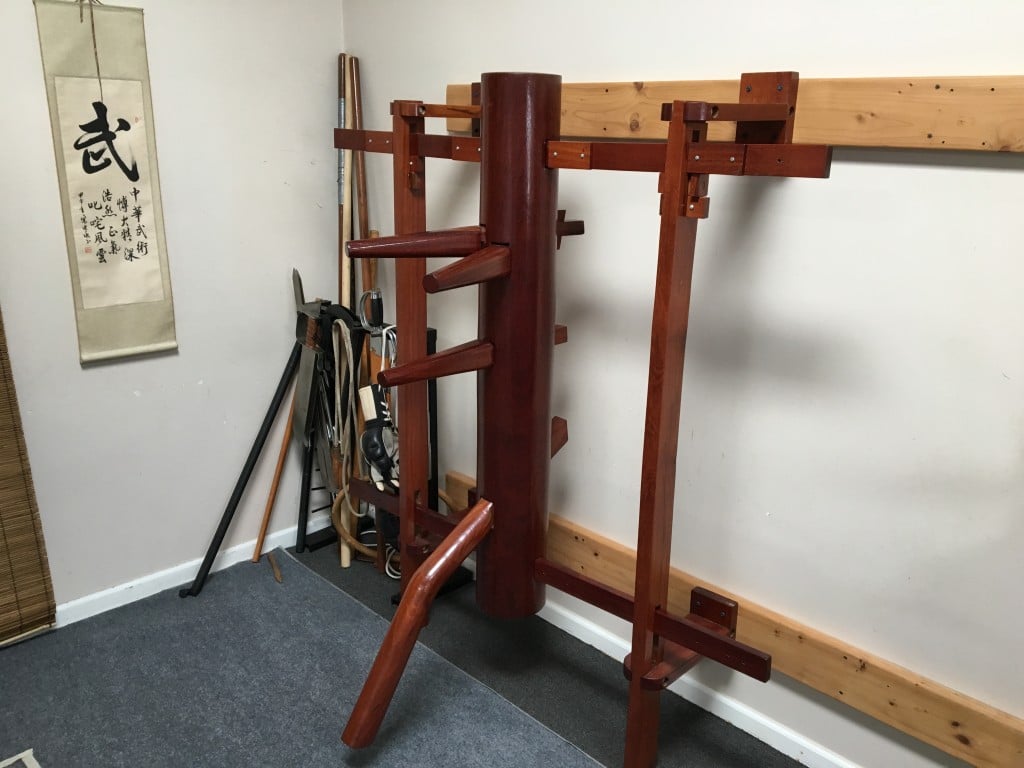
Aren’t we opening up a can of worms when we talk about traditional vs modified wing chun.
Throughout the years, I have been exposed to a wide variety of perspectives on the topic of modified Wing Chun versus traditional Wing Chun.
Both styles have been demonstrated to me, and in my opinion, it makes no difference which style of Wing Chun you practice as long as you are proficient in it.
This is something that I believe to be true because, when all is said and done, a pak is a pak, a tan is a tan, and a straight punch is a straight punch, etc.
It doesn’t really matter which school of Wing Chun you practice because the art is created by the practitioner, not the method.
There are strong combatants hailing from a variety of cultural and geographic traditions all over the world.
There are some differences between traditional vs modified wing chun though that are worth mentioning…
Traditional vs Modified Wing Chun Differences

For instance, the various Wing Chun styles all have slightly different requirements for how a person should hold a Tan Sao.
It is a load of crap to actually say that one is less effective than another. The simple truth is that you have to modify Wing Chun in order for it to work for you. You shouldn’t try to modify your form to fit Wing Chun. What comes naturally to someone else might not come as easily to you at all.
The Science of movement serves as the foundation for everything that we do. We don’t do techniques just because someone said should.
We practice these techniques because they can be demonstrated scientifically.
The fact that Sifu Phu teaches you how to listen to and interpret the flow of energy is one of the things that I appreciate most about studying under him.
That seems to be the one that needs to be mastered first and foremost.
The ability to learn how to have a conversation with your hands is something that I found to be one of the most profound aspects of the Wing Chun style.
At first glance, it might appear that people are just cycling around and attempting to collide with one another…
On the other hand, a conversation is taking place in one’s head between two different people. The first person is posing a question, and the second person is providing an answer.
There is no clear winner between the Traditional vs Modified wing chun approach. Both approaches, when all is said and done, will bring you to the same destination.
On the other hand, I feel obligated to point out that both categories contain both competent and incompetent educators.
My best piece of guidance for you is to figure out what works best for you, excel at it, and then look for a fantastic instructor to guide you along the way.
Watch Below to Hear Sifu Phu Ngo’s Thoughts About Traditional vs. Modified Wing Chun:
Related Questions To Traditional vs Modified Wing Chun
Is Traditional Wing Chun effective?
The short answer is yes of course it’s effective. Although I can’t speak about any specific school. I will say some Wing Chun schools simply don’t train with outside martial art schools.
This causes a situation where the practitioner isn’t ready to adapt to dealing with a different style. Of course the simple solution is to work on your wing chun skill vs different martial art disciplines.
How many styles of Wing Chun are there?
So I don’t think there is a hard definitive answer to this question. This is because Wing Chun is an external and internal martial art.
What this means is part of the training is about sticking to your opponent and developing your sensitivity skill.
Each person is different as is each person’s understanding of these universal things. So there are many styles. Even if we look at the main styles of Wing Chun
You Have William Chueng’s Wing Chun which is different from say Grandmaster Kwoks Wing Chun. And there are many flavors in between.
What are your thoughts about traditional vs. modified Wing Chun? Chime in below!

Hey Sifu, me again. Your biggest fan. 😉
I was wondering, with your background in multiple styles…is there a good way or guidelines to follow if you’re interested in learning more than one style? Should you give one style your whole attention for a certain amount of time then switch or can you basically learn as much as you want at the same time? Or does it depend on the person?
Hey Jacob, to me training is all the same, it’s about learning to control your body movements and how to project that out whether it be striking, locking, or building up your energy. Really it’s all based on what you can handle. Whether you can absorb the different types of techniques, how much time you have to train and how quickly your body (muscle memory) can get it down. In terms of style, like I said, don’t look at it as different systems, but as approaches on how to deal with different situations. Hope this helps. Thanks and thanks for being my biggest fan. 🙂
To add what to Sifu Phu said… To give you an idea of what he is talking about…
Sifu Larry has me practicing my Sil Lum Tao form, Tai Chi, Qigong and also learning elements of Chin Na and Wing Chun while working on C.O.R.E. exercises.
I don’t work on these all in one day, though, if you have the time you absolutely could!
Next week I will be releasing my training schedule God willing! It differs each week, however… Each thing builds on itself.
I’m releasing it, in hopes it will help you and other beginners like myself be able to have a better idea of how to train.
Out of all the styles that you have learned which was your favourite one. Also what similarities have you found between the styles that have helped you to be able to blend together the techniques you would most frequently need to use if needed?
Hi James. Of all the styles that I have learned I can’t say that I love one more than the other cause they all seem to blend in cause they all work on energy to me now. Half the time my favorite would be what style I am focusing on that month. But to kinda answer your question as to which I find that I improved my control and energy would be Tai Chi. I learned how to develop a lot of my energy control through it. But it’s not to say that the other systems didn’t help, in fact they helped me become more rounded over all. It is through the Ngo Dac Na System that I was able to break down and teach energy principles and techniques through all my training. Hope this answers your question.
i absolutely agree!!! thank you Sifu Phu and Jami for this nice interview.
In our mental attitude, i think we often tend to constantly seek a lineage or a so called, ‘style’ we belong to. That way, we find metal comfort in it, feels like i belong to something powerful. I did too. still doing it. But, when i really ponder, it’s wrong, i know. So this particular lesson is really valuable to me. Thank you!
You are very welcome Chad! For me, I feel extremely blessed I didn’t start with thinking lineage or style matters. Because in reality it does not. I think it seriously limits us, not only that but some people think they are better than others because of this need for lineage or style dominance. This causes a lot of flame wars and just bad blood inside the martial arts world, that just does not need to be there.
Glad you enjoyed it. 🙂
You guys were talking about vertical versus horizontal punches and Sifu Phu said the vertical creates a better connection. I was discussing this with someone last night and I see the advantage for a high or center punch. But what about a low punch? Wouldn’t the angle of the wrist be awkward if you used a vertical fist in a low punch?
I agree, and like they say in the Marine urhhhhhh raaaaa!
Pete Rios
I agree it is all about energy in whatever style you are in and in the physical makeup of the individual .
Completely agree with Sifu. Love how he commented that he can adjust his training techniques based on the student – the mark of a great instructor. There are many different body styles out there, based on genetics, not necessarily fat or slim. Different shapes and proportions will lead to different strengths and weaknesses. The key is to understand how the laws of physics apply to your particular body and exploit the strengths.
Absolutely brother! I have an extra fun time getting my elbows not to flare out as I am partially double jointed. It makes it a wee bit extra challenging, however over time it gets easier and easier. And yes the mark of a great teacher is the ability to adapt to not just the individuals physical challenges but also their learning style.
I join the Enter Shaolin Family back in Oct of 2016 as a lifetime member after seeing you on YouTube giving a lesson on the Muk Jong. I sign up for your ebook and 5 video lessons and was so impress that I decided to be one of your students.
I have look at different schools and online teaching, they’ve all (or most of them) taught the same form (just a little different) of training with the Muk Jong.
I need something different to make me feel different when I was training… your teaching has done that.
I feel that styles are constantly changing to suit each individual, so that they can adapt to what is being taught to them.
It is something that you have done because of the science you have put forth to make it simple to comprehend.
When you explain your reasons and demonstrate why… now that’s teaching.
My thanks for you insight.
Your welcome, we are so glad you joined. The Ngo Dac Na is very unique and I was blessed to have learned it and am honored to pass it to those who would want to learn it.
Never been critical of Traditional or Modified WC India or China or other, because aftercall the mind is like a blowing wind how to hell tame it? (GITA)
Just I think now we only just train the subconscious and superconscious never go into Mind without a Grandmaster’s explicit approval or direction.
That will seamless and streamline everything for us students and Masters as well.